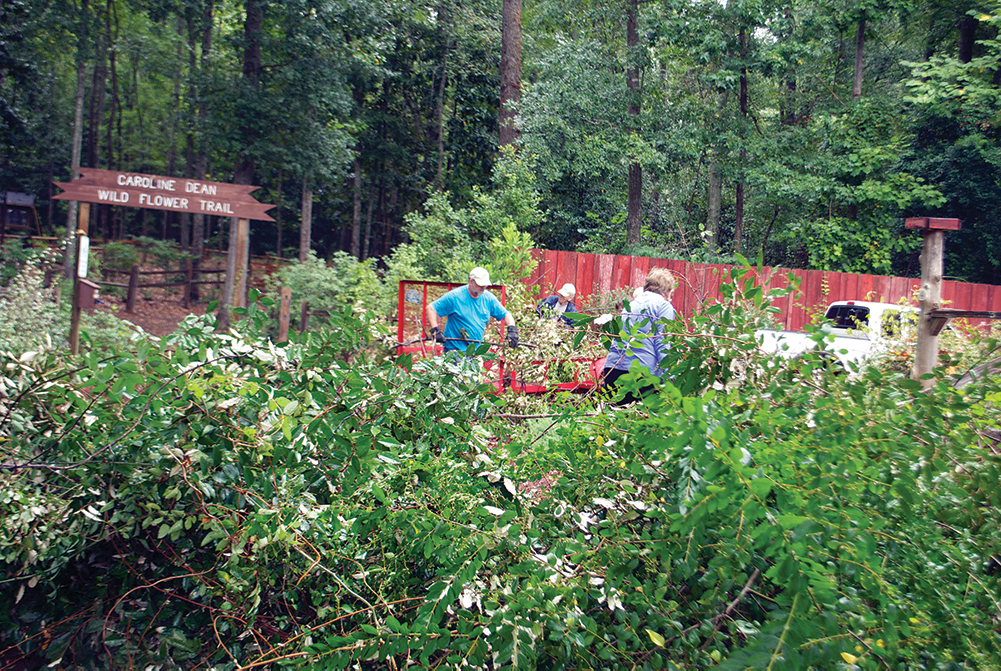How to control invasive plants in the garden
By Katie Jackson

What’s the difference between a garden variety weed and an invasive weed? The former is an annoying pest, while the latter is a serious threat. But gardeners can help in the control of both.
Weeds, often described as “plants out of place,” are unwanted plants that rob resources from preferred plants in the landscape. Invasive plants are defined as non-native (alien) species that, when introduced into an environment where they have no natural enemies, spread quickly and vigorously, soon overwhelming local ecosystems.
To be clear, not all non-native plants are invasive, and many native plants can be “weedy,” meaning they can grow aggressively and become pests. But invasive non-natives (also called exotics) aren’t just fast growing – they are bullies in the landscape that push native species out and disrupt ecosystem balance.
This imbalance threatens not just plants, but also animals, insects, microbes and other living organisms and also decreases the ecosystem functions that support all life on Earth. What’s more, battling invasives costs government agencies and private landowners billions of dollars each year.
Sad to say, while some of these invaders were introduced accidentally, many are treacherous beauties we humans introduced as ornamental plants for our gardens and landscapes. Among them are Chinese privet, thorny olive (Elaeagnus), English ivy, heavenly bamboo (nandina), non-native wisteria, leatherleaf mahonia, popcorn tree (tallowtree), mimosa and Callery (Bradford) pear. These and other exotic plants are rampant in Alabama; privet alone has infested an estimated 1 million acres in the state.

Happy to say, we gardeners can help mitigate that damage and slow, if not defeat, these invaders by starting in our own yards and communities. The first step is to know the enemy, which means learning to identify the invasive plants present in your local landscape. Identification help is available through a number of resources including the Alabama Cooperative Extension System’s Invasive Plant website (www.aces.edu/go/678), the Alabama Invasive Plant Council (www.aces.edu/go/679) and the Field Guide for the Identification of Invasive Plants (www.aces.edu/go/681).
Once you know your enemies, you can go to battle using four primary control strategies: mechanical (physically removing invasives by weeding, cutting, tilling, mowing, etc.), cultural (employing landscape practices that exclude invasive and encourage native plants), chemical (using plant targeted herbicides) and biological (introducing living organisms that are natural enemies of the invasives).
Of these, mechanical and cultural controls are the most labor intensive but often ideal for gardens and small acreages and offer a more organic approach to control. Chemical control is effective, especially in conjunction with other control measures, but should be used judiciously and according to label directions. Biological controls are harder for home gardeners to access and are typically used for large acreages, such as state parks and forestland.
Information and training to use these control measures are available through local Cooperative Extension System offices and Master Gardener groups and through Extension’s Invasive Plant website and Facebook page. Check for local invasive plant control events and programs, too.
Here are a few tips to get you started:
- Remove invasive plants before they develop seeds.
- When removing invasive plants, get as much of their roots as possible by digging or pulling invasive plant seedlings and vines after a rain when the soil is moist or using a weed wrench device on larger plants.
- Combine mechanical and chemical control methods using cut-and-spray or girdle-and-spray techniques (available at www.aces.edu/blog/topics/ control-invasive-plants/control-op- tions-for-chinese-privet/.
- Properly dispose of all invasive plant material. Disposal guidelines, which vary depending on plant species, time of year and other factors are available at https://extension.unh.edu/resources/files/resource000988_ rep1720.pdf.
- When buying plants, make sure they are not invasive species or cultivars.
- Replace non-native plants with native species. A list of alternatives can be found at www.se-eppc.org/pubs/TN-ALT.pdf.
Help your neighbors remove invasives from their yards and volunteer for community cleanup and education events.
April Tips
- Sow seeds for beans, corn, squash, melons and other summer vegetable crops.
- Begin planting tomatoes, peppers and eggplants once the threat of a hard freeze has passed.
- Fertilize warm-season lawns and plant new lawns.
- Plant summer annual flowers and summer-blooming bulbs.
- Move houseplants outside and clean dust from the leaves of indoor plants.
- Celebrate Earth Day (April 22) by planting natives, creating a pollinator garden or volunteering at a community garden.




